2014 AUDI RS7 SPORTBACK ECU
[x] Cancel search: ECUPage 128 of 292
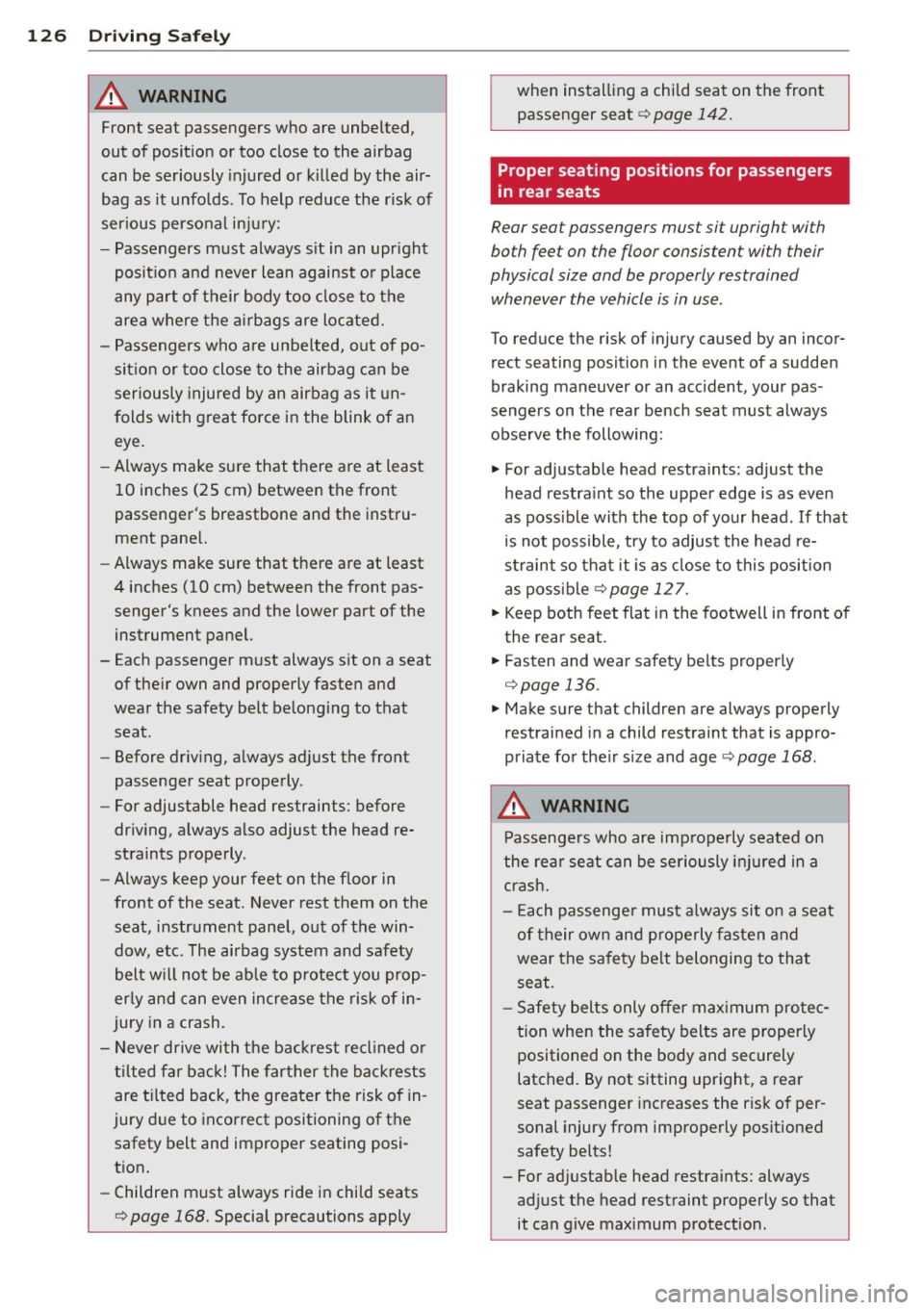
126 Driving Saf ely
A WARNING
Front seat passengers who are unbelted,
out of position or too close to the airbag
can be seriously injured or k illed by the air
bag as it unfolds . To help reduce the r isk of
ser ious personal injury:
- Passengers must always s it in an upr ight
posit ion and never lean against or place
any part of their body too close to the
area where the airbags are located.
- Passengers who are unbelted, out of po
sit ion or too close to the airbag can be
seriously injured by an airbag as it un
folds with great force in the blink of an eye.
- Always make sure that there are at least
10 inches (25 cm) between the front
passenger's breastbone and the instru
ment pane l.
- Always make sure that there are at least
4 inches (10 cm) between the front pas
senger's knees and the lower part of the
instrument panel.
- Each passenger must always sit on a seat of the ir own and properly fasten and
wear the safety belt be longing to that
seat.
- Before driving, always adjust the front
passenger seat properly .
- For adjustable head restraints: before
dr iv ing, always also adjust the head re
straints properly .
- Always keep your feet on the floor in
front of the seat. Never rest them on the
seat, instrument panel, out of the win
dow, etc. The airbag system and safety
belt w ill not be able to protec t you prop
erly and can even increase the risk of in
jury in a crash.
- Never drive with the backrest recl ined or
t ilted far bac k! The farther the back rests
are t ilted back, the greater the risk of in
jury d ue to incorrect positioning of the
safety belt and improper seating posi
t ion.
- Children must always ride in child seats
¢
page 168. Specia l precautions apply
-
when instal ling a child seat on the front
passenger seat¢
page 142.
Proper seating positions for passengers
in rear seats
Rear seat passengers must sit upright with
both feet on the floor consistent with their
physical size and be properly restrained whenever the vehicle is in use .
To reduce the risk of in jury caused by an incor
rect seating position in the event of a sudden
braking maneuver or an accident, your pas
sengers on the rear bench seat must always
observe the following:
.,. For adjustab le head restra ints: adjust the
head restra int so the upper edge is as even
as poss ible with the top of your head. If that
is not possible, try to adjust the head re
straint so that it is as close to this position
as poss ible
c;, page 127.
.,. Keep both feet flat in the footwell in front of
the rear seat .
.,. Fasten and wear safety belts proper ly
c;, page 136.
.,. Make sure that children are always properly
restrained in a child restraint that is appro
priate fo r the ir s ize and age
c::;, page 168 .
A WARNING
-Passengers who are imp roperly seated on
the rea r seat can be se riously in jured in a
crash.
- Each passenge r must always sit on a seat
of their own and p roperly fasten and
wear the safety belt belonging to that
seat.
- Safety belts only offer maximum pro te c
tion when the safety belts are properly
positioned on the body and securely
latched. By not sitting upright, a rear
seat passenger increases the r isk o f per
sonal injury from improperly pos itioned
safety belts!
- For ad justab le head restra ints: always
adjust the head restraint properly so that it can g ive maximum protect ion.
Page 130 of 292
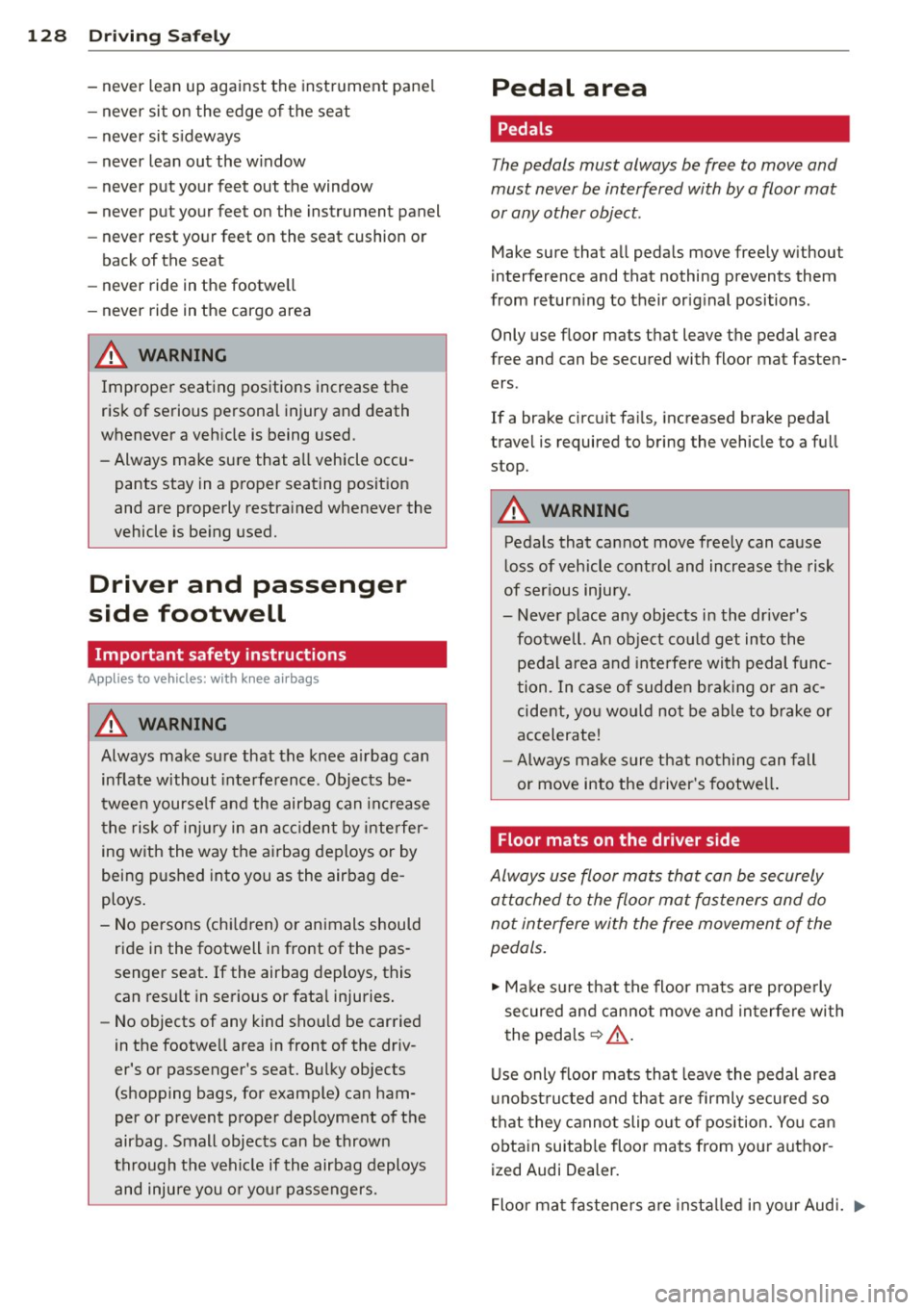
128 Driving Safely
- never lean up against the inst rument pane l
- never sit on the edge of the seat
- never sit s ideways
- never lean out the w indow
- never put your feet out the window
- never put your feet on the instrument panel
- never rest your feet on the seat cushion or
back of the seat
- never ride in the footwe ll
- never ride in the cargo area
A WARNING
Improper seating positions increase the
risk of serious personal injury and death
whenever a vehicle is being used.
- Always make sure that all vehicle occu-
pants stay in a proper seating posit ion
and are properly restra ined whenever the
vehicle is be ing used.
Driver and passenger
side footwell
Important safety instructions
Applies to vehicles: with knee airbags
A WARNING
Always make sure that the knee a irbag can
inflate without interference . Objects be
tween yourse lf and the airbag can increase
the risk of injury in an accident by interfer
ing with the way the airbag deploys or by
being pushed into you as the airbag de
ploys.
- No persons (ch ildren) or animals should
ride in the footwell in front of the pas
senger seat. If the airbag deploys, this
can result in serious or fata l injuries.
- No objects of any kind shou ld be carried
in the footwe ll area in front of the driv
er's or passenger's seat. Bulky objects
(shopping bags, for example) can ham
per or prevent proper deployment of the
airbag. Small objects can be thrown
through the vehicle if the airbag deploys and injure you or you r passengers.
-
Pedal area
Pedals
The pedals must always be free to move and
must never be interfered with by a floor mat
or any other object.
Make sure that all pedals move freely without
interference and that nothing prevents them
from return ing to their orig inal positions .
Only use floor mats that leave the pedal area
free and can be secured with floor mat fasten ers .
If a brake circuit fai ls, increased brake pedal
travel is required to bring the vehicle to a full
stop.
A WARNING ,-
Pedals that cannot move freely can cause
'
loss of vehicle control and increase the risk
of ser ious injury.
- Never place any objects in the driver's
footwell . An object could get into the
pedal area and inte rfere with pedal func
tion . In case of sudden brak ing o r an ac
cident, you wou ld not be able to brake or
accelerate!
- Always make sure that nothing can fall
or move into the driver's footwel l.
Floor mats on the driver side
Always use floor mats that can be securely
attached to the floor mat fasteners and do
not interfere with the free movement of the
pedals.
"' Ma ke sure that the floor mats are properly
secured and cannot move and in terfere with
the pedals
~ .&_.
Use only floor mats that leave the pedal area
u nobst ructed and that are firmly secured so
that they cannot slip out of position. You can
obtain suitab le floor mats from your author
ized Audi Dealer.
Floor mat fasteners are insta lled in your Audi . .,.
Page 131 of 292
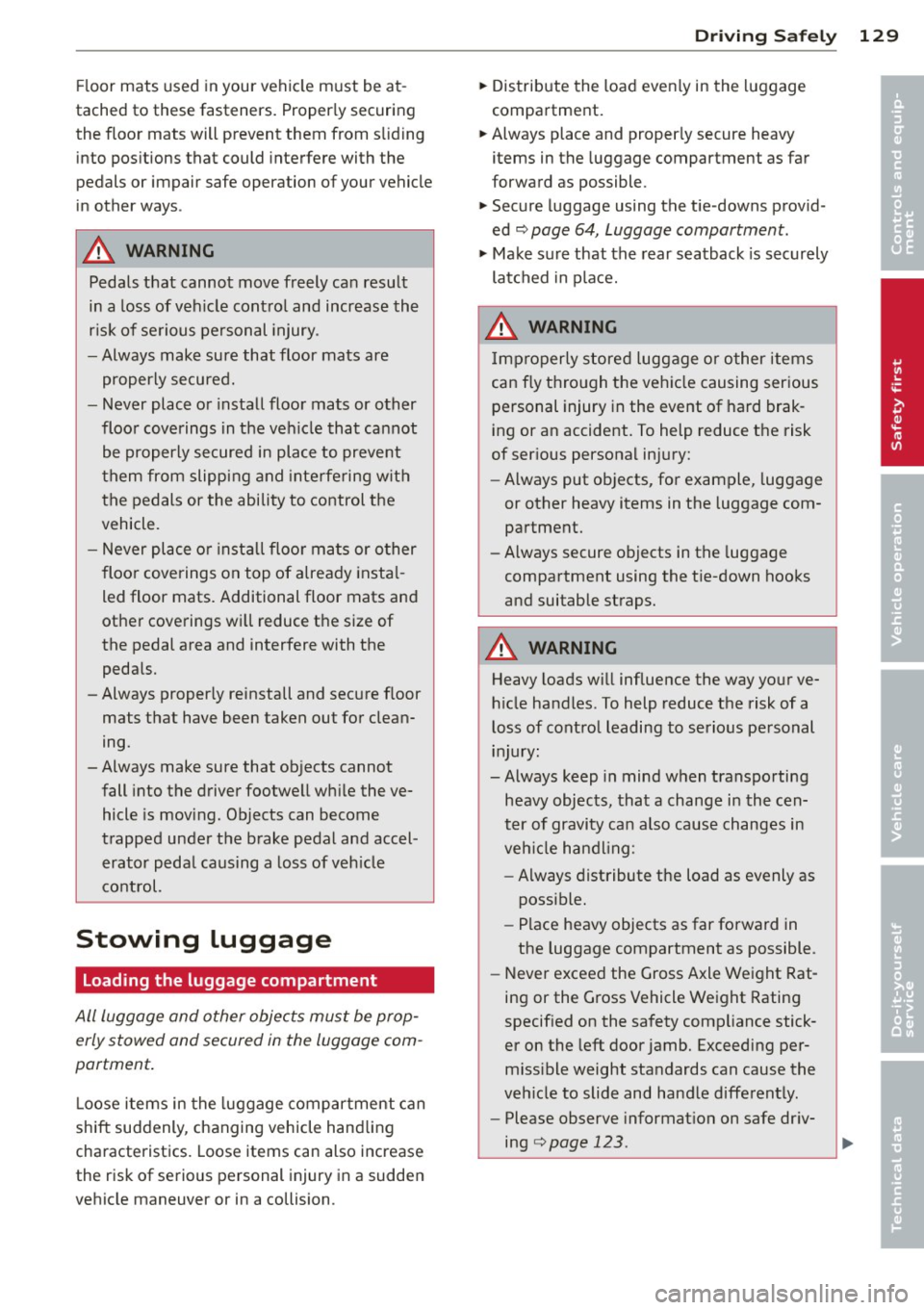
Floor mats used in your vehicle must be at
tached to these fast eners. Proper ly securing
the floor mats will prevent them from s lid ing
into positions that could interfere with the
pedals or impair safe operation of your vehicle
in other ways .
A WARNING
Pedals that cannot move freely can resu lt
in a loss of veh icle contro l and increase the
r isk o f se rious personal injury .
- Always make sure that floor mats are
properly secured.
- Never place or install floor mats or o ther
floo r coverings in the veh icle that cannot
be properly secured in pla ce to prevent
them from slipping and inte rfering w ith
the pedals or the ability to control the
vehicle.
- Never place o r inst all floo r ma ts or o ther
floo r coverings on top of already insta l
led floor mats. Additional floor mats and
other coverings wi ll reduce the size of
the pedal a rea and interfere with the
peda ls.
- Always properly reinstall and secure f loor
mats t hat have been taken out for clean
ing.
- Always make sure that ob jects cannot
fall into the driver footwe ll wh ile the ve
hicle is moving. Objects can become
t rapped under the brake pedal and accel
erator peda l causing a loss of veh icle
control.
Stowing luggage
Loading the luggage compartment
All luggage and other objects must be prop
erly stowed and secured in the luggage com
partment.
L oose items in the luggage compar tment can
shift suddenly , changing vehicle hand ling
characterist ics. Loose items can also increase
the r isk of se rious personal injury in a sudden
vehicle maneuve r or in a collision .
Driving S afel y 129
.. Distribute the load evenly in the l uggage
compa rtment .
.. Always place and proper ly secure heavy
items in the luggage compartment as fa r
forward as possible .
.. Secure luggage using the tie -downs p rov id
ed
c:> page 64, Luggage compartment.
.. Make s ure that the rear seatback is securely
la tched in place.
A WARNING
I mproperly store d luggage or other items
can fly t hro ugh the ve hicle causing ser ious
personal injury in the event of hard brak
ing or an accident. To help reduce the risk
of ser ious persona l injury:
- Always put objects, for exam ple, luggage
or other heavy items in the luggage com
partment.
- Always secure objects in the luggage
compartment using the t ie-down hoo ks
a nd suitable straps.
A WARNING
Heavy loads w ill influence the way yo ur ve
h icle handles . To help reduce the risk of a
loss of cont ro l leading to serious pe rsonal
injury :
- Always keep in mind when transporting
heavy objects, that a change in the cen
ter of gravity can also cause changes in
veh icle han dling:
- Always distribute the load as evenly as
possible.
- Place heavy objects as far forward in
the luggage compartment as possible.
- Never exceed the Gross Axle Weight Rat
ing or the G ross Vehicle We ight Rating
specified on the sa fety comp liance stick
er on the left door jamb. Exceeding per
miss ible weight standards can cause the
ve hicle to slide and hand le different ly .
- Please observe informat ion on safe dr iv
ing
c:>page 123.
•
•
Page 132 of 292

130 Driving Safely
&_ WARNING
-
To help prevent poisonous exhaust gas
from being drawn into the vehicle, always keep the rear lid closed while driving .
- Never transport objects larger than
those fitting completely into the luggage
area because the rear lid cannot be fully
closed.
- If you absolutely must drive with the rear
lid open, observe the following notes to
reduce the risk of poisoning:
- Close all windows,
- Close the power roof*,
- Open all air outlets in the instrument
panel,
- Switch off the air recirculation,
- Set the fresh air fan to the highest
speed.
&_ WARNING
Always make sure that the doors, all win
dows, the power roof* and the rear lid are
securely closed and locked to reduce the
risk of injury when the vehicle is not being
used.
- After closing the rear lid, always make
sure that it is properly closed and locked.
- Never leave your vehicle unattended es
pecially with the rear lid left open. A
child could crawl into the vehicle through
the luggage compartment and close the
rear lid becoming trapped and unable to
get out . Being trapped in a vehicle can
lead to serious personal injury.
- Never let children play in or around the
vehicle .
- Never let passengers ride in the luggage
compartment . Vehicle occupants must
always be properly restrained in one of
the vehicle's seating positions.
(D) Tips
- Air circulation helps to reduce window fogging. Stale air escapes to the outside
through vents in the trim panel. Be sure
to keep these slots free and open .
-
-The tire pressure must correspond to the
load. The tire pressure is shown on the
tire pressure label. The tire pressure la
bel is located on the driver's side B-pillar.
The tire pressure label lists the recom mended cold tire inflation pressures for
the vehicle at its maximum capacity
weight and the tires that were on your
vehicle at the time it was manufactured.
For recommended tire pressures for nor
mal load conditions , please see chapter
r::!) page 232.
Tie-downs
The luggage compartment is equipped with
four tie-downs to secure luggage and other
items.
Use the tie-downs to secure your cargo prop
erly ¢
page 129, Loading the luggage com
partment.
In a collision, the laws of physics mean that
even smaller items that are loose in the vehi
cle will become heavy missiles that can cause
serious injury. Items in the vehicle possess en
ergy which vary with vehicle speed and the
weight of the item. Vehicle speed is the most
significant factor.
For example , in a frontal collision at a speed
of 30 mph (48 km/h), the forces acting on a 10-lb (4.5 kg) object are about 20 times the
normal weight of the item. This means that
the weight of the item would suddenly be about 200 lbs. (90 kg). You can imagine the
injuries that a 200 lbs . (90 kg) item flying
freely through the passenger compartment
could cause in a collision like this.
&_ WARNING
Weak, damaged or improper straps used
to secure items to tie-downs can fail dur
ing hard braking or in a collision and cause
serious personal injury.
- Always use suitable mounting straps and properly secure items to the tie-downs in ..,.
Page 133 of 292
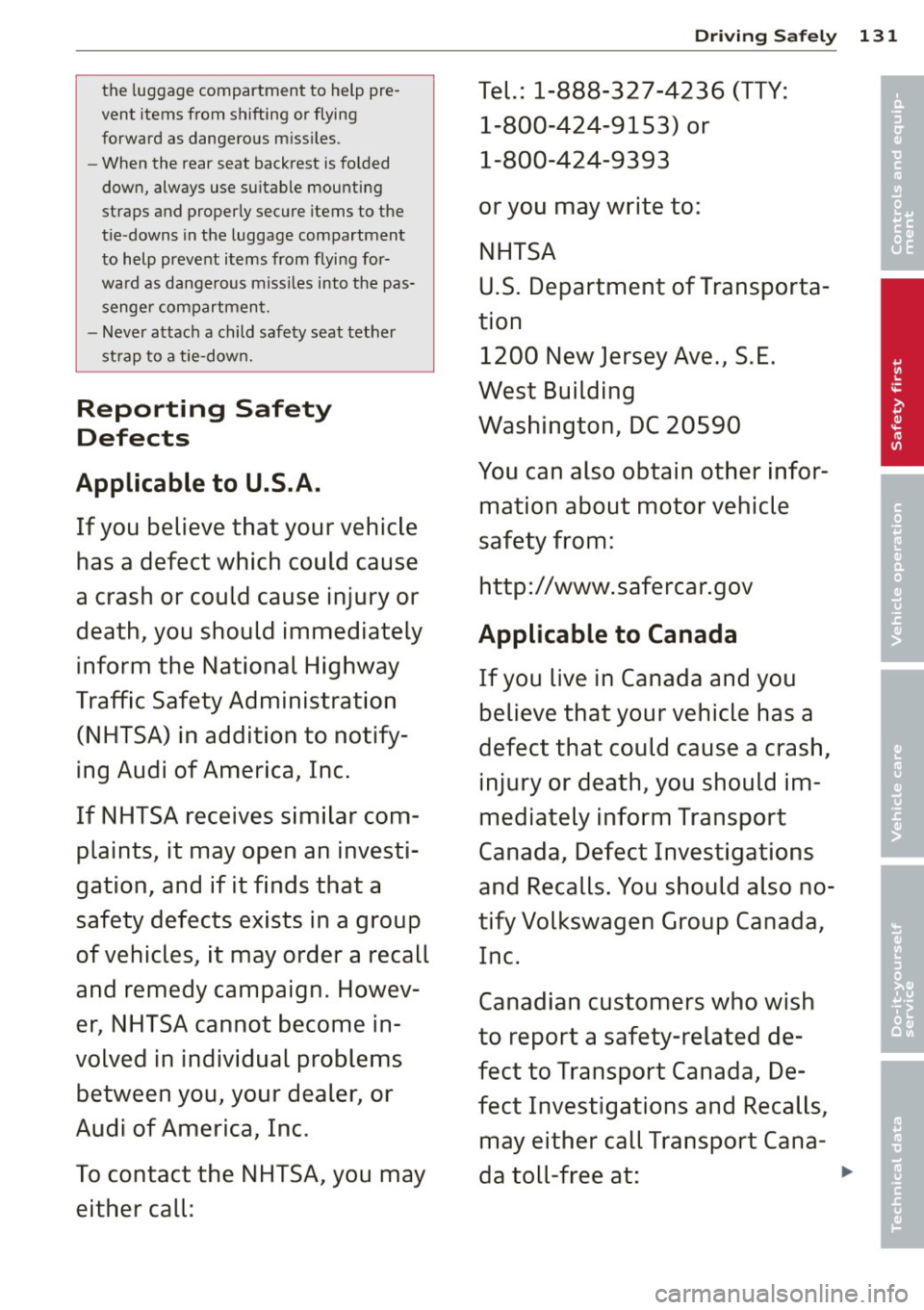
the luggage compartment to help pre
vent items from shifting or flying
forward as dangerous missiles .
- When the rear seat backrest is folded
down, always use suitable mounting
straps and properly secure items to the
tie -downs in the luggage compartment
to help prevent items from flying for
ward as dangerous missiles into the pas senger compartment.
- Never attach a child safety seat tether
strap to a tie-down.
Reporting Safety
Defects
Applicable to U.S.A.
If you believe that your vehicle
has a defect which could cause
a crash or could cause injury or
death, you should immediately
inform the National Highway
Traffic Safety Administration (NHTSA) in addition to notify
ing Audi of America, Inc.
If NHTSA receives similar com
plaints, it may open an investi
gation, and if it finds that a
safety defects exists in a group
of vehicles, it may order a recall
and remedy campaign. Howev
er, NHTSA cannot become in
volved in individual problems
between you, your dealer, or
Audi of America, Inc.
To contact the NHTSA, you may
either call:
Driving Safely 131
Tel.: 1-888-327-4236 (TTY:
1-800-424-9153) or
1-800-424-9393
or you may write to:
NHTSA
U.S. Department of Transporta
tion 1200 New Jersey Ave., S.E.
West Building
Washington, DC 20590
You can also obtain other infor
mation about motor vehicle
safety from:
http://www.safercar.gov
Applicable to Canada
If you live in Canada and you
believe that your vehicle has a
defect that could cause a crash,
injury or death, you should im
mediately inform Transport
Canada, Defect Investigations
and Recalls. You should also no
tify Volkswagen Group Canada,
Inc.
Canadian customers who wish
to report a safety-related de
fect to Transport Canada, De
fect Investigations and Recalls, may either call Transport Cana-
da toll-free at: ""
•
•
'
Page 138 of 292
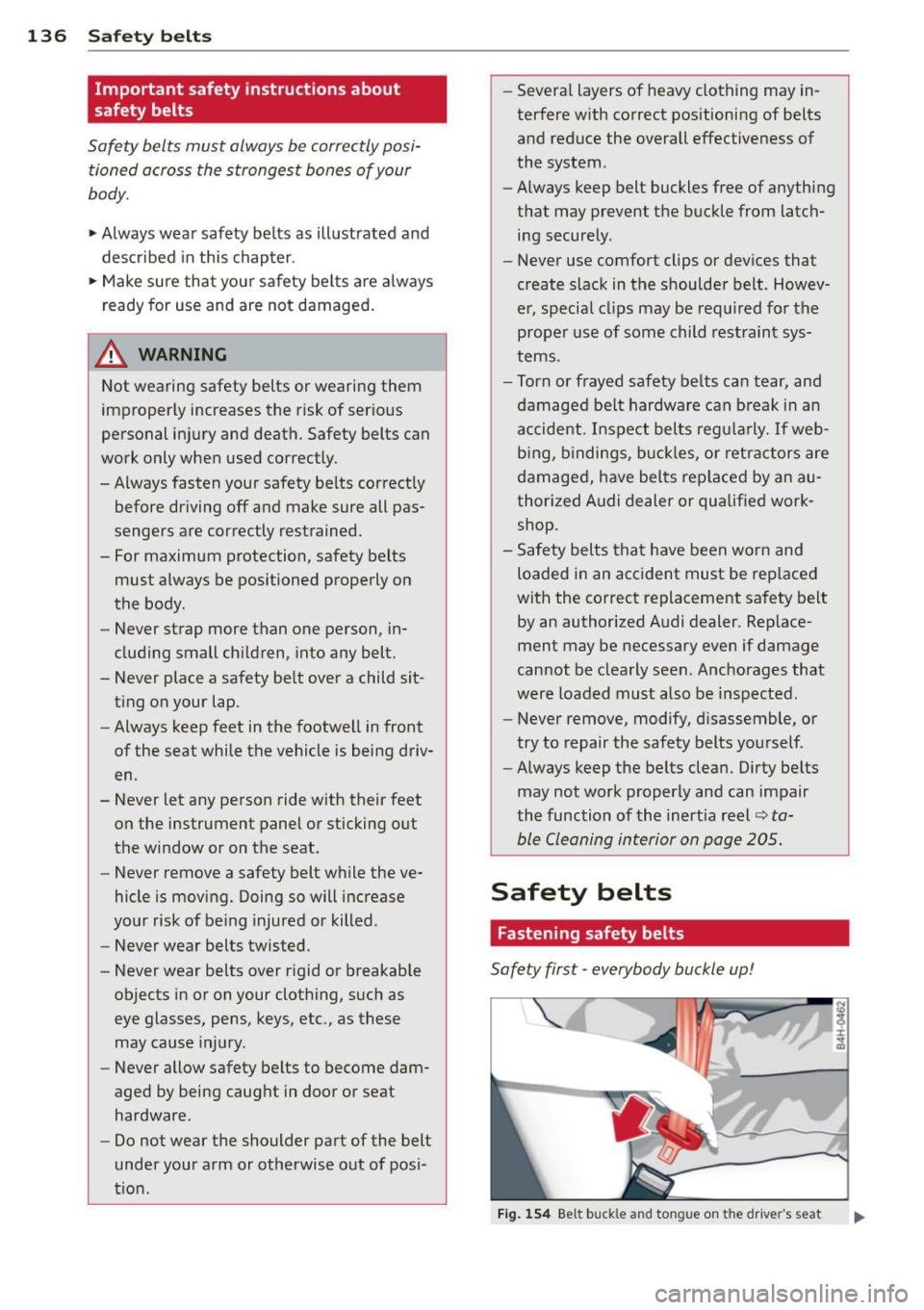
136 Safety belts
Important safety instructions about
safety belts
Safety belts must always be correctly posi
tioned across the strongest bones of your
body.
,.. Always wear safety belts as illustrated and
described in this chapter.
,.. Make sure that your safety belts are always
ready for use and are not damaged.
A WARNING
Not wearing safety belts or wearing them
improperly increases the risk of serious
personal injury and death. Safety belts can
work only when used correctly .
- Always fasten your safety belts correctly
before driving
off and make sure all pas
sengers are correctly restrained.
- For maximum protection, safety belts must always be positioned properly on
the body .
- Never strap more than one person , in
cluding small children, into any belt.
- Never place a safety belt over a child sit ting on your lap.
- Always keep feet in the footwell in front
of the seat while the vehicle is being driv
en .
- Never let any person ride with their feet on the instrument panel or sticking out
the window or on the seat.
- Never remove a safety belt while the ve
hicle is moving. Doing so will increase
your risk of be ing injured or killed.
- Never wear belts twisted.
- Never wear belts over rigid or breakable
objects in or on your clothing, such as
eye glasses, pens, keys, etc., as these
may cause injury.
- Never allow safety belts to become dam
aged by being caught in door or seat
hardware .
- Do not wear the shoulder pa rt of the belt
under your arm or otherwise out of pos i
tion . -
Several layers of heavy clothing may in
terfere with correct positioning of belts
and reduce the overall effectiveness of
the system .
- Always keep belt buckles free of anything
that may prevent the buckle from latch
ing securely .
- Never use comfort clips or devices that
create slack in the shoulder belt . Howev
er, special clips may be required for the
proper use of some child restraint sys
tems .
- Torn or frayed safety belts can tear, and
damaged belt hardware can break in an
accident. Inspect belts regularly .
If web
bing, bindings, buck les, or retractors are
damaged, have belts replaced by an au
thorized Audi dealer or qualified work
shop.
- Safety belts that have been worn and
loaded in an accident must be replaced
with the correct replacement safety belt
by an authorized Audi dealer . Replace
ment may be necessary even if damage
cannot be clearly seen . Anchorages that
were loaded must also be inspected.
- Never remove, modify, disassemble, or
try to repair the safety belts yourself.
- Always keep the belts clean. Dirty belts
may not work properly and can impair
the function of the inert ia reel
c::> ta
ble Cleaning interior on page 205 .
Safety belts
Fastening safety belts
Safety first -everybody buckle up!
Fig. 154 B elt buck le and to ngue o n th e drive r's se at
Page 139 of 292
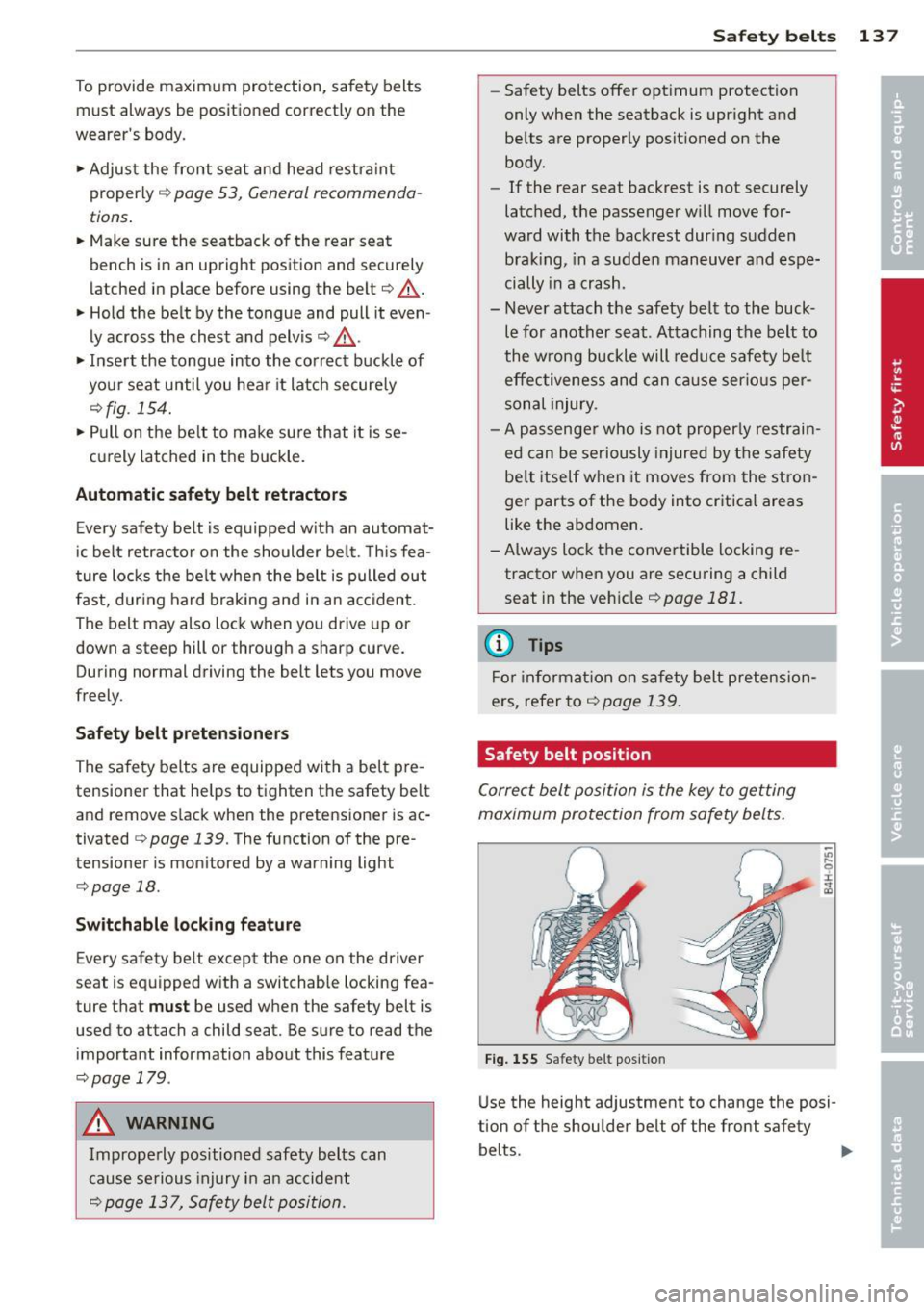
To provide maximum protection, safety belts
must always be positioned correctly on the
wearer's body .
... Adjus t the front seat and head restraint
properly
c::> page 53, General recommenda
tions .
... Make sure the seatback of the rear seat
bench is in an upright position and securely
latched in place before using the belt
c::> ,&. .
... Hold the be lt by the tongue and pull it even
ly across the chest and pelvis
c::> ,&..
... Insert the tongue into the co rrect buckl e of
your seat until you hea r it latch securely
c::>fig . 154.
... Pull on the belt to make sure that it is se-
curely latched in the buckle.
Automatic safety belt retractors
Every safety belt is equipped w ith an automat
i c belt retractor on the shoulder be lt. T his fea
ture locks the belt when the belt is pulled out
fast, dur ing hard braking and in an accident.
The belt may also lock when you drive up or
down a steep hill or through a sharp curve.
During normal driving the belt lets you move
freely.
Safety belt pretensioners
The safety belts are equipped with a belt pre
tensioner that helps to tighten the safety belt
and remove slack when the pretensioner is ac
tivated
c::> page 139. The function of the pre
tensioner is mon itored by a warning light
c::> page 18 .
Switchable locking feature
Every safety belt except the one on the driver
seat is equipped w ith a switchable locking fea
ture that
must be used when the safety belt is
used to attach a child seat. Be sure to read the
important information about this feature
c::> page 179.
A WARNING
Improperly positioned safety belts can
cause se rious injury in an accident
c::> page 13 7, Safety belt position.
Safety belts 13 7
-Safety belts offer optimum protection
only when the seatback is upright and
be lts are properly posit ioned on the
body .
- If the rear seat backrest is not securely
latched, the passenger will move for
ward with the backrest during sudden braking, in a sudde n maneuver and espe
cially in a crash.
- Never attach the safety belt to the buck
l e for another seat . Attaching the belt to
the wrong buckle will reduce safety be lt
effec tiveness and can cause serious per
sonal injury.
- A passenge r who is not properly restrain
ed can be seriously injured by the sa fety
be lt itself when it moves from the stron
ger parts of the body into critical areas
like the abdomen.
- Always lock the conve rtible locking re
tractor when you are securing a child seat in the veh icle
~ page 181.
(D Tips
For info rmat ion on safety belt pretension
e rs, refer to
c::> page 139.
Safety belt position
Correct belt position is the key to getting
maximum protection from safety belts .
Fig. 155 Safe ty belt posit ion
Use the height adjustment to change the posi
tion of the shoulder belt
of the front safety
belts.
~
Page 140 of 292
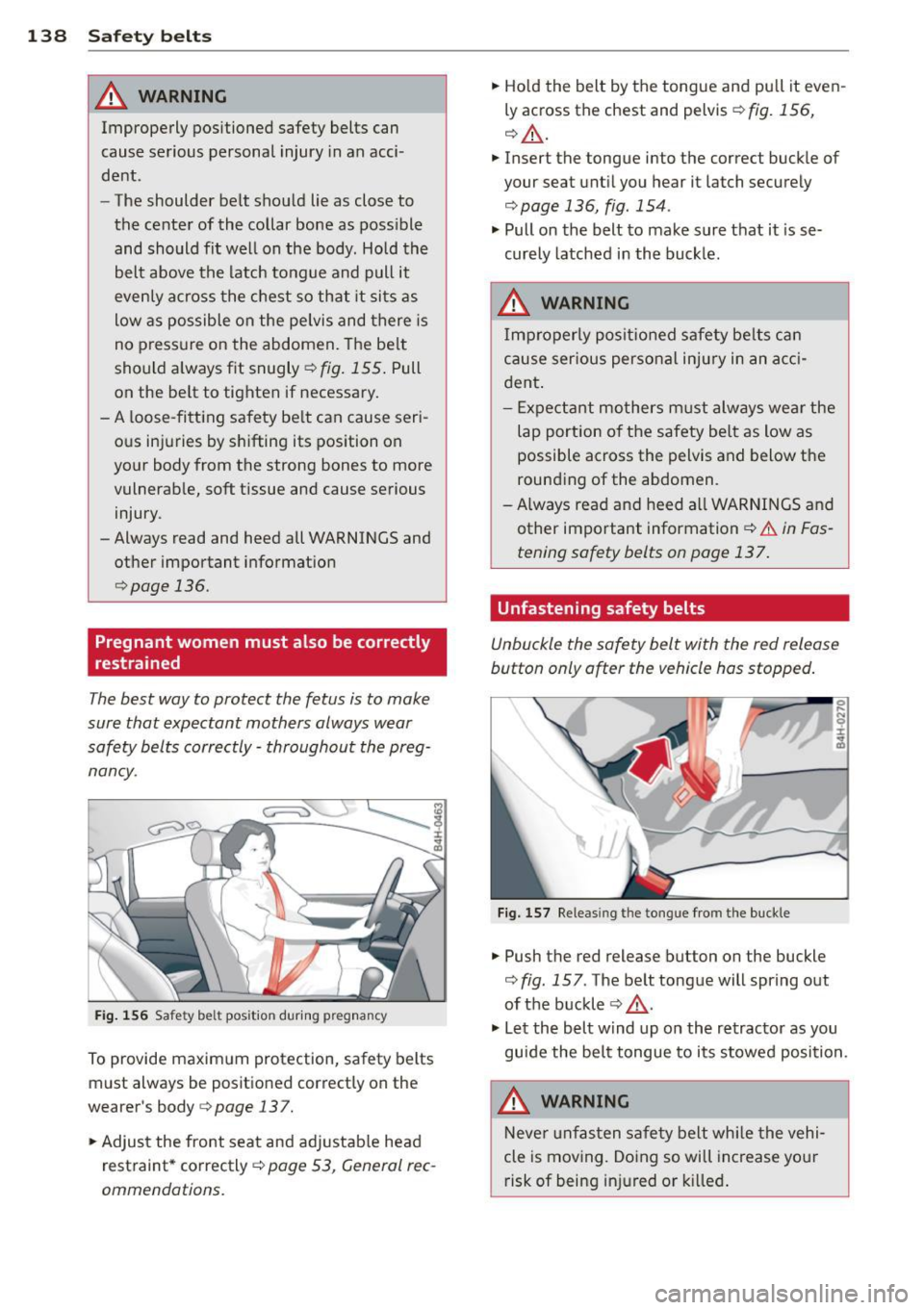
138 Safety belts
& WARNING
Improperly positione d safety belts can
cause serious personal injury in an acci
dent.
- The shoulder belt should lie as close to
the center of the collar bone as possible
and should fit well on the body. Hold the
belt above the latch tongue and pull it
evenly across the chest so that it sits as
low as possible on the pelvis and there is
no pressure on the abdomen. The belt
should always fit snugly¢
fig. 155. Pull
on the belt to tighten if necessary.
-A loose-fitting safety belt can cause seri
ous injuries by shifting its position on
your body from the strong bones to more
vulnerable, soft tissue and cause serious injury.
-Always read and heed all WARNINGS and
other important information
¢page 136.
Pregnant women must also be correctly
restrained
The best way to protect the fetus is to make
sure that expectant mothers always wear safety belts correctly -throughout the preg
nancy.
Fig. 156 Safety belt position during pregnancy
To provide maximum protection, safety belts
must always be positioned correctly on the
wearer's body
¢ page 137.
"'Adjust the front seat and adjustable head
r estraint * correctly ¢
page 53, General rec
ommendations.
"'Hold the belt by the tongue and pull it even
ly across the chest and pelvis¢
fig. 156,
¢ _&..
"' Insert the tongue into the correct buckle of
your seat until you hear it latch securely
¢page 136, fig. 154.
"' Pull on the belt to make sure that it is se
curely latched in the buckle.
& WARNING
Improperly positioned safety belts can
cause serious personal injury in an acci
dent.
-
- Expectant mothers must always wear the
lap portion of the safety belt as low as
possible across the pelvis and below the
rounding of the abdomen.
- Always read and heed all WARNINGS and
other important information¢.&.
in Fas
tening safety belts on page 137.
Unfastening safety belts
Unbuckle the safety belt with the red release
button only after the vehicle has stopped.
Fig. 157 Releas ing the tongue from the buckle
"' Push the red release button on the buckle
¢ fig. 157. The belt tongue will spring out
of the buckle
¢ ,& .
"' Let the belt wind up on the retractor as you
guide the belt tongue to its stowed position.
& WARNING
Never unfasten safety belt while the vehi
cle is moving. Doing so will increase your
risk of being injured or killed.